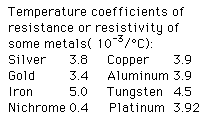Resistance: Temperature Coefficient
Since the electrical resistance of a conductor such as a copper wire is dependent upon collisional proccesses within the wire, the resistance could be expected to increase with temperature since there will be more collisions. An intuitive approach to temperature dependence leads one to expect a fractional change in resistance which is proportional to the temperature change:

Or, expressed in terms of the resistance at some standard temperature from a reference table:

| Calculation | Low temperature resistivity | Superconductivity |
DC Circuits


